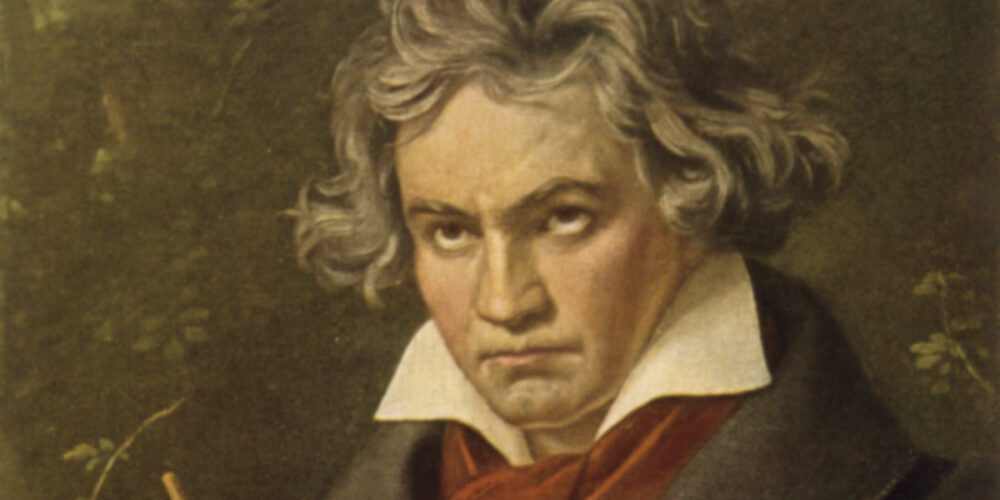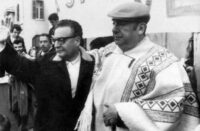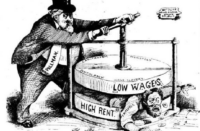Like few other composers, Beethoven expresses the will for freedom, the democratic longing of the people. His music is the continuation of the French Revolution through the means of art; his Ninth Symphony is a hymn to the humanist utopia of the equality of all humankind.
Beethoven’s Ninth Symphony
The Ninth Symphony was composed in 1823, but Beethoven had planned from his youth to set Schiller’s “Ode to Joy” to music. Schiller’s poem, expressing the aspiration of the age of revolutions, was close to his own thinking all his life.
The years since composing his Eighth Symphony had been times of bitter disappointment at the oppressive, reactionary political developments after the Congress of Vienna but also of personal suffering. They were also years of growing resistance to reaction and the revival of the revolutionary ideals betrayed by the upper middle classes.
The Ninth Symphony symbolises powerfully the struggle through night into light, of progress against reaction, to which Beethoven dedicated his whole life and work. It is often expressed in a struggle between a dark minor key and a brilliant affirmative major key. The finale of the Ninth Symphony anticipates and celebrates the victory of this ideal: a future society in which freedom, equality, universal fellowship is fulfilled, in which Joy can reign.
The first movement portrays a great battle, heroic resistance against adverse conditions. Beethoven described Metternich’s reactionary state as the “chaos and despair in which we live.” This is enacted in the dark opening bars, and theme 1 is in despairing D minor. The heroic theme breaks through powerfully in B flat major, with a first anticipation of the Joy melody. This polarity between minor and major represents the symphony’s two protagonists.
At the end of the movement the struggle has not been resolved; the state of “despair” is challenged, not eliminated. A solemn funeral march in D Minor moves the movement to a dark ending, yet it finishes with a gesture of defiance and belief in victory, with the heroic motif played in unison.
The second movement opens in D minor but transitions into a joyful dance in F major. The entire orchestra plays a stamping dance theme. The recapitulation increases the sense of busy tumult; the coda follows with lively movement. Oboes and clarinets play a cheerful tune, reminiscent of Slavic folk music. This powerful folk melody, the joy of the people, has entered the first movement’s joyless world, with the movement ending brilliantly and optimistically in D major.
The third movement contrasts with the second movement’s active participation in life with a wonderful adagio, a dreamlike vision of longed-for human happiness and peace. The first violins sing the soulful main theme; its variations make the movement increasingly fluid. Suddenly, signal-like fanfares promise victory, sounding into the dream. The melody swings upwards, offering beautiful glimpses of that world of longed-for peace and joy.
The crowning final movement evokes life in community, in happiness and peace, a utopian vision. Beethoven merged the instrumental and the vocal, for the first time in symphonic music, to express these revolutionary ideals, won through struggle, with the help of human singing.
At the beginning of the final movement Beethoven surveys the ground that has to be traversed in order to reach this utopia, the hard-won realm of joy and freedom. The wild, dissonant outcry in thundering D minor recalls the gloomy opening of the first movement. The recollected restless scherzo theme is not yet a source of true joy; neither is the dreamy melody of the third movement’s adagio. Beethoven prepares the ground musically by having the low strings represent the hero, who gradually rejects the main themes of the preceding three movements, until finally they embrace the “Ode to Joy” theme and with it the message of universal humankind.
This simple melody is in the manner of a folk tune. It is a tune expressing human community, of people who have succeeded in the great feat, as Schiller’s poem says, and who are called to transform the world from a state of despair into a world of general peace, joy, and freedom. Beethoven now sings his high song to Joy. We are still in the realm of wordless music.
In a very lively orchestral movement we hear the triumphal march of the Joy theme. At first, violas and cellos take over the melody, accompanied by the contrapuntal voices of double basses and bassoons. Then the Joy theme grows in the polyphonic choir of instruments to the triumphant march of the whole orchestra. A sudden pause, voices of doubt assert themselves; a cry of horror threatens to plunge everything into despair. Now the baritone singer, the voice of humanity, enters.
The march swells to a mighty storm. Even the joy of the human community can only be achieved through struggle. The two, peace and joy, are inseparable. The choir triumphs with the Joy melody in the splendour of the full orchestra in D major. Human community is emphasised. Beethoven sings of the “gentle wing” of peace, which shines in the beauty of the solo quartet. A roaring orchestral epilogue with variations of the Joy melody concludes this powerful symphony.
Touring Syria in 2017, we visited a multi-denominational primary school in Homs. Suicide-bombers had slaughtered thirty children and many parents. Here young girls greeted us, movingly singing in Arabic the “Ode to Joy”: “Alle Menschen werden Brüder”: All people are joined in common humanity.
The European Union adopted “Ode to Joy” as its anthem in 1985; yet the EU’s stringent sanctions on Syria make it more difficult for food, fuel and health facilities to reach the people. Such measures fly in the face of Beethoven’s humanist message.






